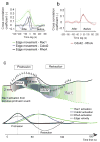Coordination of Rho GTPase activities during cell protrusion
- PMID: 19693013
- PMCID: PMC2885353
- DOI: 10.1038/nature08242
Coordination of Rho GTPase activities during cell protrusion
Abstract
The GTPases Rac1, RhoA and Cdc42 act together to control cytoskeleton dynamics. Recent biosensor studies have shown that all three GTPases are activated at the front of migrating cells, and biochemical evidence suggests that they may regulate one another: Cdc42 can activate Rac1 (ref. 8), and Rac1 and RhoA are mutually inhibitory. However, their spatiotemporal coordination, at the seconds and single-micrometre dimensions typical of individual protrusion events, remains unknown. Here we examine GTPase coordination in mouse embryonic fibroblasts both through simultaneous visualization of two GTPase biosensors and using a 'computational multiplexing' approach capable of defining the relationships between multiple protein activities visualized in separate experiments. We found that RhoA is activated at the cell edge synchronous with edge advancement, whereas Cdc42 and Rac1 are activated 2 micro-m behind the edge with a delay of 40 s. This indicates that Rac1 and RhoA operate antagonistically through spatial separation and precise timing, and that RhoA has a role in the initial events of protrusion, whereas Rac1 and Cdc42 activate pathways implicated in reinforcement and stabilization of newly expanded protrusions.
Figures




Comment in
-
Sensing and controlling protein dynamics.Nat Rev Mol Cell Biol. 2010 Oct;11(10):680-1. doi: 10.1038/nrm2985. Nat Rev Mol Cell Biol. 2010. PMID: 20861876 No abstract available.
References
-
- Jaffe AB, Hall A. Rho GTPases: Biochemistry and Biology. Annual Review of Cell and Developmental Biology. 2005;21:247–269. - PubMed
-
- Burridge K. Wennerberg, K., Rho and Rac Take Center Stage. Cell. 2004;116(2):167–179. - PubMed
-
- Ridley AJ, et al. Cell Migration: Integrating Signals from Front to Back. Science. 2003;302:1704–1709. - PubMed
-
- Kraynov V, et al. Localized Rac Activation Dynamics Visualized in Living Cells. Science. 2000;290:333–337. - PubMed
-
- Nalbant P, Hodgson L, Kraynov V, Toutchkine A, Hahn KM. Activation of Endogenous Cdc42 Visualized in Living Cells. Science. 2004;305:1615–1619. - PubMed
Publication types
MeSH terms
Substances
Grants and funding
LinkOut - more resources
Full Text Sources
Other Literature Sources
Molecular Biology Databases
Research Materials
Miscellaneous

